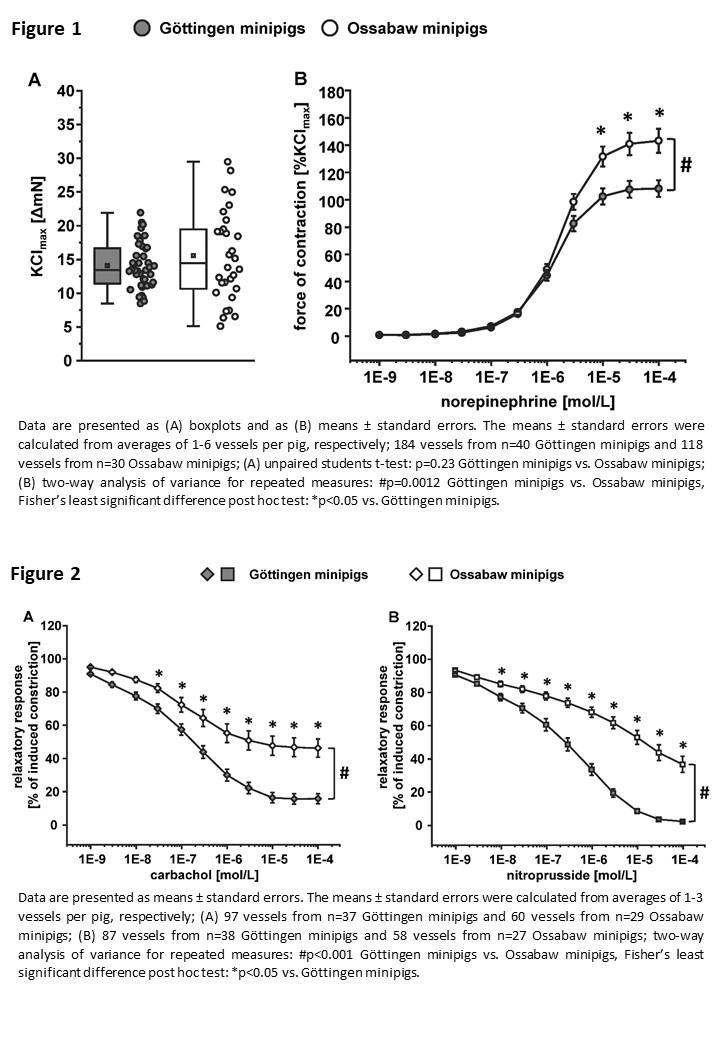Background: The metabolic syndrome predisposes and contributes to the development and progression of atherosclerosis. An early manifestation of atherosclerosis is endothelial dysfunction, which results in an imbalance between relaxing and contractile factors. The “Ossabaw” minipig strain is characterized by a genetic predisposition to develop a metabolic syndrome upon high fat diet (1,2). We have investigated whether Ossabaw minipigs exhibit an altered vasomotor function even before they develop a metabolic syndrome. Therefore, we used isolated mesenteric arteries from adult lean Ossabaw minipigs and, for comparison, adult Göttingen minipigs without such genetic predisposition.
Methods: In terms of the 3Rs of animal use in research, we generated these data from pigs which originally underwent cardioprotection studies (2-4). Mesenteric arteries are characterized by a comparable receptor arrangement as arteries of other vascular territories, e.g. coronary arteries and therefore provide a useful bioassay preparation (5). Isolated mesenteric arteries from both minipig strains were harvested post mortem, dissected, and mounted on a small vessel wire myograph for isometric force measurements. Vasoconstriction to potassium chloride (KCl) was induced (twice 0.6 × 10−1 mol/L and twice 1.2 × 10−1 mol/L), and maximal vasoconstriction to KCl (KClmax) was quantified as a reference. Cumulative concentration-response curves were determined in response to 1 × 10−9 mol/L – 1 × 10−4 mol/L norepinephrine. Endothelium‑dependent and ‑independent vasodilation were measured in response to carbachol and nitroprusside (1 × 10‑9 mol/L – 1 × 10−4 mol/L, each) after pre-constriction with norepinephrine (1 × 10−4 mol/L).
Results: Vasoconstriction in response to KCl was comparable between Ossabaw and Göttingen minipigs (Figure 1A). In vessels from Ossabaw minipigs, vasoconstriction in response to norepinephrine was more pronounced than in those from Göttingen minipigs (Figure 1B), and there was less endothelium-dependent (Figure 2A) and ‑independent vasodilation (Figure 2B).
Conclusion: Even before the development of the metabolic syndrome, vasomotor function is altered in Ossabaw minipigs, suggesting a genetic predisposition for the early development of a vascular dysfunction. Thus, Ossabaw minipigs may resemble the human situation of early atherosclerosis.

1. Sturek M, Alloosh M, Sellke FW. Swine disease models for optimal vascular engineering. Annu Rev Biomed Eng 22: 25-49, 2020.
2. Kleinbongard P, Lieder HR, Skyschally A, Alloosh M, Gödecke A, Rahmann S, Sturek M, Heusch G. Non-responsiveness to cardioprotection by ischaemic preconditioning in Ossabaw minipigs with genetic predisposition to, but without the phenotype of the metabolic syndrome. Basic Res Cardiol 117: 58, 2022.
3. Kleinbongard P, Lieder H, Skyschally A, Heusch G. No sex-related differences in infarct size, no-reflow and protection by ischaemic preconditioning in Göttingen minipigs. Cardiovasc Res 119: 561-570, 2023.
4. Lieder HR, Skyschally A, Sturek M, Heusch G, Kleinbongard P. Remote ischemic conditioning in Ossabaw minipigs induces the release of humoral cardioprotective triggers, but the myocardium does not respond with reduced infarct size. Am J Physiol Heart Circ Physiol 323: H1365-H1375, 2022.
5. Kleinbongard P, Konorza T, Boese D, Baars T, Haude M, Erbel R, Heusch G. Lessons from human coronary aspirate. J Mol Cell Cardiol 52: 890-896, 2012. https://dgk.org/kongress_programme/ht2023/aBS160.html